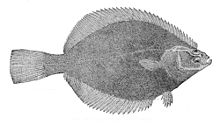
Flounders are a group of flatfish species. They are demersal fish, found at the bottom of oceans around the world; some species will also enter estuaries.

Citharichthys is a genus of flatfish in the large-tooth flounder family, Paralichthyidae. They have both eyes on the left sides of their heads. They are native to the oceans around the Americas, with a single species, C. stampflii off the West African coast. Most are found in relatively shallow depths, but the genus also includes species found in deep water and species that enter fresh water.
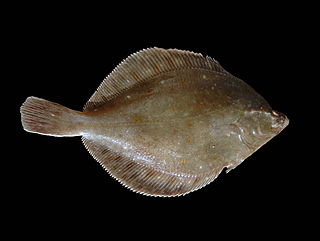
Pleuronectidae, also known as righteye flounders, are a family of flounders. They are called "righteye flounders" because most species lie on the sea bottom on their left sides, with both eyes on their right sides. The Paralichthyidae are the opposite, with their eyes on the left side. A small number of species in Pleuronectidae can also have their eyes on the left side, notably the members of the genus Platichthys.

The yellowbelly flounder is a flatfish of the genus Rhombosolea, found around New Zealand. A different species from the genus Rhombosolea is found in Australia and also goes by the name yellow-belly flounder. The Māori people have commonly fished for R. leporina, and many other species of flatfish, throughout New Zealand's coastal waters for hundreds of years. The Māori name for this species is pātiki tōtara.

The greenback flounder is a righteye flounder of the genus Rhombosolea, found around southern Australia and New Zealand.

The yellowtail flounder, also known as the rusty dab, is a species of flatfish in the family Pleuronectidae. Reaching 56 cm (22 in) in length, it has reddish brown upperparts, pale underparts and yellow fins. Both its eyes are on the right (upper) side of its body. Found in the western North Atlantic, it has been fished commercially by North American fisheries for food. A victim of overfishing, the yellowtail flounder is categorized as "Vulnerable" by the International Union for Conservation of Nature.

Pleuronectes is a genus of righteye flounders found in the northern oceans.
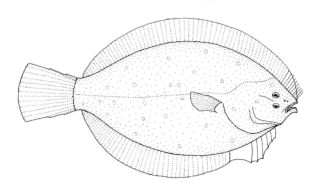
Rhombosolea is a genus of righteye flounders. The four species in this genus can be found in the waters around New Zealand and southern Australia.
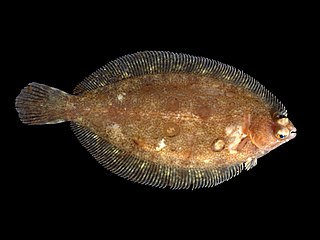
Microstomus is a genus of righteye flounders native to the North Pacific and Northeast Atlantic oceans.
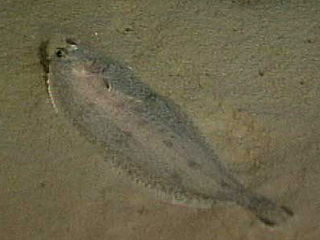
Glyptocephalus is a genus of righteye flounders found in the North Atlantic and North Pacific Oceans

The Citharidae or largescale flounders are a small family of flounders with four genera. Three genera are restricted to the Indo-Pacific, while Citharus is from the Mediterranean and East Atlantic. There are a total of seven species. Species reach lengths ranging between 14 and 36 centimetres.

Bothus is a genus of flatfish in the family Bothidae from the Pacific, Indian and Atlantic Oceans. Some species in this genus have spots consisting of blue rings.

Chascanopsetta is a genus of flatfish in the family Bothidae found in deeper parts of the Pacific and Indian Oceans with a single species, C. lugubris also occurring in the Atlantic Ocean. It contains ten member species.

The willowy flounder is a flatfish of the family Pleuronectidae. It is a demersal fish that lives on bottoms at depths of between 100 and 200 metres. Its native habitat is the temperate waters of the Western Pacific, from Southern Hokkaido in Japan to the Gulf of Bohai, the East China Sea and Taiwan. It can grow up to 30 centimetres (12 in) in length. It is sometimes classified in the monotypic genus Tanakius.

The Arctic flounder, also known as the Christmas flounder, eelback flounder and Polar plaice, is a flatfish of the family Pleuronectidae. It is a demersal fish that lives on coastal mud bottoms in salt, brackish and fresh waters at depths of up to 90 metres (300 ft). Its native habitat is the polar waters of the northeastern Atlantic and Arctic oceans, from the White and Barents seas to the coasts of Siberia in Russia and Queen Maud Gulf in Canada, and from the Chuckchi and Bering seas to Bristol Bay in Alaska and the northern Sea of Okhotsk. It can grow up to 35 centimetres (14 in) in length.

The scaldfishes comprise a genus, Arnoglossus, of lefteye flounders. They are found in the Pacific, Indian and Atlantic Oceans, including the Mediterranean and Black Sea. They are entirely absent from most of the Americas; the only exceptions are A. coeruleosticta and A. multirastris found off Chile. The genus include both species found in shallow and deeper water. The largest species reaches 28 cm (11 in).

Engyprosopon is a genus of small lefteye flounders. They are found in the Indo-Pacific, ranging from shallow coastal waters to depths in excess of 400 m (1,300 ft).

Paralichthys is a genus of large-tooth flounders. Most species are native to the coastal waters of the Americas, but P. olivaceus is from northeast Asia. The largest species reaches about 1.5 m (5 ft) in length.

Syacium is a genus of large-tooth flounders found in the Atlantic and Pacific Oceans. With the exception of S. guineensis from the Atlantic coast of Africa, all species are from the Americas. The largest species in the genus reaches 40 cm (16 in) in length.
